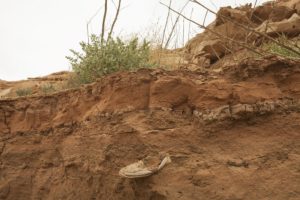 I’ve always had a thing about mud, which is to say, about in-between places. As a boy roaming the Lake Michigan beaches there was nothing better than climbing the “clay hills,” an eroding bluff whose bare gray face was constantly calving off in sharp-edged chunks during the summer, or oozing slowly downhill during the wet of winter. That mud could take on any texture, from iron-hard to sloppy pudding puddles to perfect modeling clay.
I’ve always had a thing about mud, which is to say, about in-between places. As a boy roaming the Lake Michigan beaches there was nothing better than climbing the “clay hills,” an eroding bluff whose bare gray face was constantly calving off in sharp-edged chunks during the summer, or oozing slowly downhill during the wet of winter. That mud could take on any texture, from iron-hard to sloppy pudding puddles to perfect modeling clay.
These days, Flagstaff being a generally tidied-up sort of place long on tourists to impress and short on water sources, I have to go further afield to find good mud. The best is along the rivers that cut through the plateau, the San Juan and Green and Colorado and their smaller feeder streams, where each bend that slows the water’s velocity forms a perfect testbed for ooze and slurp and slime. Back when I worked as a field biologist and got out a lot, I spent a morning exploring upstream along Laguna Creek, up east of Kayenta, where a coworker named Aaron and I pretty much literally got sucked into playing with the jelly mud to see how much we could make it wiggle and jiggle before it gave way and pulled us in—almost, but never quite, enough so that we couldn’t get back out. Another time, along the Escalante River in southern Utah, I hiked in the flowing water and was surprised how quickly one could get pulled down into entirely unseen mudholes under the knee-deep stream.
But the mother lode of river mud, these days, has got to be Lake Powell, that great half-dried-up reservoir that is half lake, half river, with its vast acreages of fresh muck in between. I’ve made a number of visits there in recent years, working on a book project with the photographer Peter Goin, and my primary interest was the mud that piles up where the rivers pour in: the vast mudflats lined with juvenile tamarisk and tumbleweeds, the eroding cutbanks, the weird oleaginous mudpots six feet across that are shaped like shield volcanoes and that burp water at unpredictable intervals.
One time, kayaking, a friend and I saw in the mysterious terrain where the Colorado slowed to form the lake a jagged spit of gray mud. It looked like a low, rocky island: a place where the dissolved muck of the river had somehow coalesced around itself like a new sun forming itself out of interstellar dust.
It was, I thought, some of the newest land on earth, and I wanted in on it. On this heavily used and imperiled planet it was one place on which probably no one had ever set foot: a sort of terra incognita, even if it was only a few dozen square feet in size. It was fresh, and had something of the pristine about it.
Getting there was no problem, as the current carried us straight there. We drifted downstream with small bits of driftwood and inescapable plastic debris: a stray lighter, little bits of Styrofoam, a crushed water bottle. Within a minute we were near the island. I veered toward it and tried to pull myself to its shore with my paddle.
I guess I was hoping for the feel of rock clad in mud. Instead the paddle sank in the way a spoon sinks into a bowl of chocolate pudding. I pushed harder on the paddle: no resistance. The island wasn’t rock at all; it was nothing but mud. How deep was it? Deep enough that there was no way to find out without leaving the paddle there for good.
With a jerk, I pulled the paddle out; I’d need it to get home. The new land would have to remain virginal. It wasn’t ready for human beings. Our occupation, if it were to come at all, would have to wait a while longer.
Now the project is done and the book, which is shaped around Peter Goin’s artful photographs of place, ended up being about this sense of being in between—which is the way Lake Powell is at a time when temperatures are rising and winter snow isn’t falling as reliably as it once did. Designed as a blue-water holding pool for two years’ worth of Colorado River flow, the reservoir is probably for a long time going to remain a place in between: in between solid and liquid, land and water, walking and paddling—which means: silty brown water, oozing mudflats, strange revelations of the garbage left behind last season, or last century.
Yes, it’s mucked up. But working with a talented photographer showed me that it’s also beautiful, in ways that are unpredictable and that rely on the poetry of the moment. That’s out there, wherever we look, if we just take the time to take it in.
Peter Friederici is a writer and a former itinerant field biologist and tour guide who in his spare time directs the Master of Arts Program in Sustainable Communities at Northern Arizona University.

